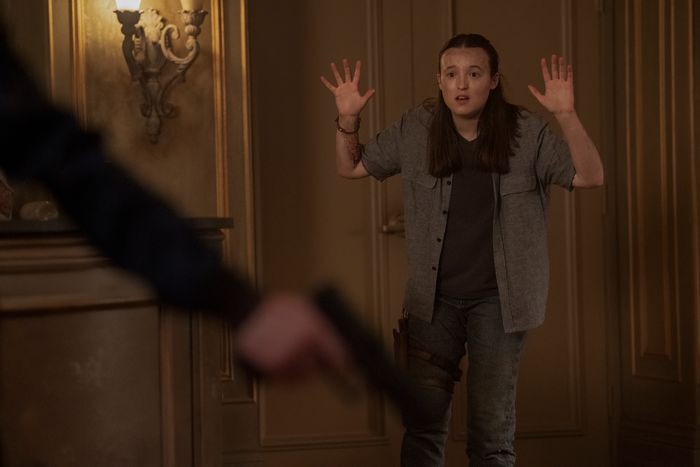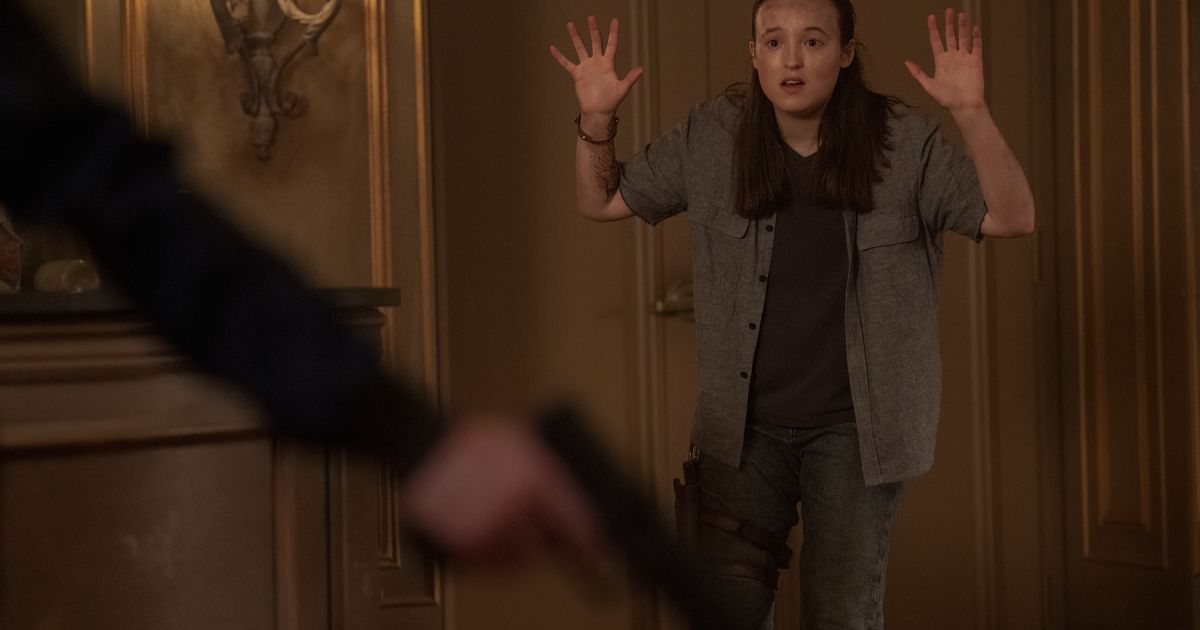
Photo: Liane Hentscher/HBO
Spoilers ahead for the season-two finale of HBO’s The Last of Us as well as the video game it adapts.
You could call it a twist, but that word is always tricky when you’re talking about a video game as globally popular as The Last of Us Part II — but a twist it is. At the end of “Convergence,” the second-season finale of HBO’s adaptation of the Naughty Dog franchise, Abby (Kaitlyn Dever) gets the jump on the Jackson crew in an abandoned Seattle theater. In a swift sequence, Jesse (Young Mazino) is shot in the face as he barrels into the room where Abby is holding Tommy (Gabriel Luna) at gunpoint, and Ellie (Bella Ramsey) is finally confronted with the consequences of her desire to avenge Joel (Pedro Pascal). Furious and distraught, Abby yells, “I let you live, and you wasted it!” Another gunshot rings out, followed by a cut to black. When the finale resumes, the story loops back to three days earlier but with the narrative gaze settled on Abby, indicating that the next season will explore her side of those three fateful days in Seattle.
This perspective switcheroo is lifted directly from the game, which is structured in two opposing halves. Aside from a prologue in which you control Joel (and, briefly, Abby in a quick nod to the switch to come), you play the opening half from Ellie’s point of view as she sets out with Dina to exact revenge on Abby and her crew. What transpires in the first 12 hours or so of gameplay roughly aligns with the show’s second season from a structural standpoint: Joel is killed, Ellie and Dina make for Seattle, and there Ellie kills a few of Abby’s buds (Nora, Mel, and Owen, plus two more characters who don’t appear in the show) before the theater showdown when Abby gets the jump on the Jackson crew. That first half of the game builds up to the exact same cliffhanger as this second season: gunshot, cut to black, reversal.
The twist of the perspective shift is designed to feed a primary theme that Neil Druckmann, who co-directed the game and serves as showrunner for the HBO version alongside Craig Mazin, has framed Part II as being about: tribalism, or the varying sense of who is seen as an enemy or as a person. Without divulging the specifics of the second half, the gist is that reexperiencing the events of the three days in Seattle from Abby’s perspective messes with Ellie’s positioning as a hero on a quest to avenge her father figure. It’s a flashy technical concept born of a fundamentally straightforward thesis, one far less novel than that explored in both The Last of Us Part I and the first HBO season.
Despite the simplicity of its episodic road-trip structure, Part I is rooted in a devilishly thorny idea. Joel is a monster — an asshole, in Ellie’s parlance — and no matter how much you may empathize with his motivations as a parent, his choice to save Ellie and kill the surgeon, Abby’s father, in the Salt Lake City hospital, thus likely erasing any chance for a cure, is morally unconscionable. But multiple things can be true at the same time. The guy can be a monster who doomed humanity and a dad who made an understandable decision and someone you root for even as some part of you feels queasy about his choices. The mishmash of those layers is accentuated by you, the player, having controlled Joel as a character this whole time and thus having partial ownership over his heinous/heroic acts. (At least that’s the intent. You’ll find no shortage of players who’d argue Joel was unambiguously correct.) The gambit of Part II involves scaling up and exporting that internal conflict. An innocent in the first game, Ellie goes on to commit horrific murders on what you initially read as a rootable impulse. Because Abby shanked the guy you spent the previous game embodying, you initially view her as a villain, but as you explore her perspective, she gets reframed as a mirror to Ellie whose actions can be justified. As that happens, you’re meant to wonder about your original relationship to the story: You’re rooting for the bond between Ellie and Joel, aren’t you? Now do you still root for them?
I didn’t particularly like The Last of Us Part IIlargely because the spirit of the perspective shift struck me too on the nose. Frankly, a tear about the game is. One of its more prominent aesthetic flourishes is a mechanic in which enemies respond to your killing one of their buds by sadly calling out their fallen comrade’s names. The device is meant to evoke a tinge of remorse in the player, but it starts to lose meaning and attains a sheen of absurdity when it happens for the hundredth time. The perspective shift suffers from the same feeling of overarching repetition, but nevertheless, as a means of executing a thematic concept, it still works in the context of the game. Once you hit the cliffhanger in the Seattle theater, you immediately flow from Ellie’s perspective into Abby’s, and the dissonance of that switch works because Ellie’s experience of those three days — and her bringing death to Nora, Mel, and Owen — is still fresh in the player’s mind. head.
This won’t be the case with the show. It looks even though it’ll be quite some time before the third season hits HBO, and by then, you may be struggling to remember who Nora, Mel, and Owen even are. But the more fundamental reason the structural twist works in the game is specific to the medium itself: Because the game puts you in Abby’s shoes, and simply because it’s longer, you have so much more time to embody her perspective and internalize the conflict the game wants you to feel. Put simply, it has a radically larger surface area for generating empathy in a way television naturally has to be more surgical about.
At present, it’s not apparent whether Mazin and Druckmann can pull off this trick, and it strikes me as a clear instance in which the duo have remained a little too faithful to the source material. HBO’s The Last of Us is shaping up to be a pretty fascinating case study in uneven adaptation, with the tension between what they chose to change and what they decided to keep becoming particularly apparent in this second season. A great deal of the material created specifically for the show unambiguously works: the first season’s standout episode, “A Long Long Time”; set pieces like the Battle of Jackson; new characters like Catherine O’Hara’s Gail; new stand-alone scenes like the 1960 talk-show segment that kicks off the series. (Most, not all: I thought the first season wasted Melanie Lynskey.) After all, it is television, and you need distinctly television things to make a series pop.
Yet Mazin and Druckmann make smaller logistical tweaks that rearrange certain emotional frameworks in the narrative in ways that either simplify or sand down the edges too much. One minor example: In the game, a broken and vengeful Tommy heads off to Seattle first, which gives Ellie a bit more of a permission structure to run off from Jackson; in the show, Ellie is the spearhead, and her recklessness is unquestionably apparent. One major example: The near reconciliation between Ellie and Joel at the end of the sixth episode, “The Price,” is actually the final scene in the game and involves a remarkably huge tweak. In the source material, Ellie extracts Joel’s confession a few years before their chat on the porch, which means not only that there was a longer period of estrangement between the two — wasted years before Joel’s death — but also that the gap between Joel’s confession and Ellie’s gesture towards possible reconciliation is near-immediate. A rich emotional morass has been a little too streamlined.
Perhaps these differences are leading up to a larger idea distinct from the source material that the HBO series will try to execute later on, but I doubt it. For all the tweaks Mazin and Druckmann have made to refashion the narrative to better fit the box of serialized television, it’s hard not to wonder if the duo could have been bolder about this. Perhaps the perspective shift could’ve been ditched for a structure that braided Ellie’s and Abby’s stories together; perhaps we could have gotten to the flip more quickly. As it stands, by following through in such a straightforward manner, HBO’s The Last of Us has made the experience of watching from this point on feel like a fait accompli. Even if you aren’t familiar with the game, the final moments of season two communicate that we’re set for a deeper slog into a moral abyss, one you can probably already tell leads nowhere good.
See All

اترك تعليقاً